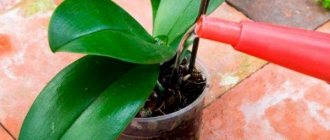Why might a plant die?
The main reasons why a plant dies may be:
- Excessive watering . Overwatering a plant can cause its roots to begin to rot, and if nothing is done right away, the flower will disappear.
- Long stay without moisture . The plant stops receiving nutrients, vital processes stop and it dries out (what to do if spathiphyllum does not grow?).
- Hypothermia of the root system . This may occur if immediately after watering the plant is exposed to cold air.
- Excess of nutrients . Leads to chemical burn of roots. This often happens due to improper use of fertilizers.
Consequences of waterlogging
If the housewife carelessly flooded the spathiphyllum, you should pay attention to whether a corresponding symptom has appeared, by which you can accurately determine the cause of the deterioration of the flower’s condition. Visually, it is defined as darkening of the tops of the shoots; if such a picture is present, you should know that a rotting process has begun, which very quickly spreads throughout all parts of the plant. Rotting of the root system is especially dangerous, and in 90% of cases the flower dies.
In order to help him, it is important to know at what stage the putrefactive process is. There's no need to guess what to do. You just need to take the flower by the stem and pull it slightly, as if trying to pull it out. If the shoot comes out easily, then it is most likely too late to revive it, since most of the root system has died, and the remaining parts of the flower have also atrophied.
How to understand what is missing?
The plant needs help when such signs appear.:
- The leaves turn black.
- The leaf blades lose their elasticity and become sluggish (why can spathiphyllum droop its leaves?).
- The tops of young leaves darken.
- The foliage turns yellow and dries out.
- The roots become dark and hollow to the touch.
Diseases and pests that cause spathiphyllum to wither
Diseases and pests often cause changes in foliage color and deformation of the leaf plate. If you take a closer look at the spathiphyllum and find that tiny insects live on the back of the leaves and on the stems, and the flower itself has begun to droop, most likely it has been attacked by aphids. In this case, the plant must be treated with pyrethrum. The procedure is repeated every 14 days until the pest disappears.
It may be that when examining the flower, red small insects and a thin cobweb covering everything around were noticed. This is a spider mite. It can be expelled with insecticides, which are treated once every 14 days until the insect completely disappears.
Find out what to do if your spathiphyllum leaves turn black.
It is also possible that the foliage has drooped, the soil and the root part of the stems are covered with mold. This is how gray rot appears, which occurs due to waterlogging. You need to dry the soil with napkins and clean the drainage holes in the pot. If the plant does not come to life, you should examine its roots; perhaps the disease has affected them too. If there are diseased roots, spathiphyllum is transplanted.
Step-by-step instruction
What can I do to revive the plant?
In order to save spathiphyllum, first of all, it is necessary to analyze the conditions under which the flower is kept and understand the possible reason for its poor health.
The tips of the leaves darken
The possible cause of the problem lies:
- In dry air – in this case, it is necessary to take action to humidify the air around the plant.
To do this you can:- Spray spathiphyllum leaves with a spray bottle.
Use a humidifier.
- Place a container of water next to the flower pot.
- In excess watering – in this case, a large area of the edge of the leaf plate turns black. Therefore, you need to know that you cannot flood the plant, and if this happens, you should do the following:
- Trim off browned leaves.
- Dry 1/3 of the soil in which the flower is planted.
- Check to see if excess water is draining from the pot.
- Then reduce the frequency of watering.
You can find out why spathiphyllum flowers and leaves darken here.
Below is a visual and informative video about the reason for the darkening of the leaf tips of spathiphyllum:
The flower turns yellow
This problem may be caused by:
- Sunburn - if the spathiphyllum is exposed to direct sunlight. The leaves lose not only their healthy color, but also their elasticity. They become like a thin sheet of papyrus.
You can fix the problem as follows:- Place the flower in a place with diffused light.
Trim diseased leaves (read more about the main diseases of spathiphyllum here).
- Feed the plant with fertilizer. The complex fertilizer "Reasil" has proven itself well.
- Lack of microelements – in this case, the leaf acquires an uneven yellow color.
You can eliminate the yellowing of spathiphyllum due to a lack of microelements as follows:- Replant the flower in new soil.
Spray the plant with complex fertilizer containing boron and calcium.
- Water the plant with warm and soft water.
Below is a video about the yellowing of spathiphyllum leaves:
The leaves are fading
- Dried soil - the most common cause of leaf wilting. To fix the problem it is enough:
- Water the plant.
- Sometimes, if the soil is very dry, you can completely place the flower pot in a container of water
- Heterogeneous soil – a common cause for newly purchased indoor potted flowers. Store-bought soil absorbs moisture well, but forms a hard lump around the root system, preventing the penetration of oxygen to the roots.
Your actions:- Remove the spathiphyllum from the pot.
Clean the roots as much as possible from the old soil.
- Transplant the flower into new soil, not forgetting the need to create good drainage.
- Root rotting - a reason requiring immediate intervention. It is necessary in a timely manner:
- Remove the plant from the pot.
- Inspect the roots and remove rotten ones with a knife.
- Replant the spathiphyllum or proceed as described below, depending on the results of the examination.
Read more about why spathiphyllum withered and how to save the plant here.
Below is a visual video about resuscitation of a plant when its leaves wilt:
What to do if all the roots have rotted?
Most often, the cause of death of spathiphyllum is problems with the root system. A healthy spathiphyllum root is white and elastic in structure.
If there is a suspicion of rotting of the root system, then the following actions must be taken:
- Remove the plant from the pot.
- Shake off any remaining soil from the roots and rinse them in warm water.
- Carefully examine the root system and use a sharp knife to cut off all rotten roots down to living tissue. Soft, dark and empty roots must also be removed.
- Sprinkle the cut areas with ash or sulfur powder.
- Treat the roots with a weak solution of fungicide or potassium permanganate.
- Leave the plant in the air, allowing the roots to dry out.
- Then place the flower in a container of water with the addition of a root formation stimulator. You can use a folk remedy by dissolving 1 tsp. honey in 1 liter. water.
- The water should be changed regularly.
- As soon as the spathiphyllum begins to grow a root system, it can be planted in the ground.
- When planting, special attention should be paid to the drainage layer.
- The plant is not watered immediately after transplantation.
- In the future, within a month, it is recommended to feed the plant with a root formation stimulator.
The drugs "Epin" and "Zircon" will be excellent helpers in the fight for the life of your pet. A good folk remedy for increasing plant immunity is an infusion of eggshells. To prepare it, you need to pour warm water over the shells of 10 chicken eggs and leave them for a week. This product has an unpleasant odor, but is an effective fertilizer for indoor plants. - When watering, you must ensure that there is no stagnation of water in the pot and remove all excess liquid from the pan in a timely manner.
Next, we suggest watching a video about how spathiphyllum with rotten roots is transplanted:
What to do to save a drooping flower?
If the leaves become limp and the flower wilts, in most cases the plant can be revived by replanting, which should be done according to the algorithm given below:
- Remove the plant from the bowl along with a lump of earth, being careful not to damage the roots.
- Carefully free the flower from excess soil by washing it off with water at room temperature.
- Inspect the roots for affected areas.
- Trim off diseased, empty, damaged shoots, leaving only healthy ones.
- Grind the activated carbon tablet into dust. Sprinkle the powder on the cuts to stop the rotting process.
- Place the flower on napkins so that the rhizomes dry slightly. A couple of hours will be enough.
- Fill a suitable-sized pot with light, fresh soil from leaf soil, peat, coarse sand, charcoal and humus, having first placed a drainage layer on the bottom.
- Lightly moisten the soil.
- Plant a flower.
- Moisten the soil again.
Important! If only the leaves of a flower have wilted, and there are no plans to replant it yet, you should not fill it with water to save it, since you first need to establish why the problem arose.
If the soil is dry, abundant watering is contraindicated for the plant . It must be moistened with small portions of water, and then the surface of the soil must be covered with film, repeating the procedure every two days.
In case of excessive watering, the plant must be dried by reducing the one-time amount of liquid. When affected by diseases and insect pests, the flower is treated with special insecticidal solutions.
Preventing problems
High-quality care for spathiphyllum will be the main measure to prevent problems with the plant.
- First of all, the plant needs good lighting without direct sunlight. The east or west sides of the house are ideal for maintenance.
- The temperature in the growing area should not be lower than 22 degrees.
- It is necessary to regularly water the plant with warm, settled or boiled water.
- It is necessary to ensure that there is no stagnation of moisture - all water, after watering, should drain into the pan within 15 minutes.
- Every two years the plant needs to replace the soil. When transplanting a plant into new soil, the root system avoids oxygen starvation, which can occur when the soil is compressed.
- Replanting begins when the plant reaches three years.
Spathiphyllum is a spectacular plant. If you follow the rules of care, it will not require resuscitation and will fill your home with beauty.
Ways to revive an indoor flower
Knowing how to revive a houseplant can come in handy when all hope seems lost. However, we should not forget that the sooner measures are taken to restore the condition of the flower, the greater the chance that it will return to normal. We are actively taking measures to save the flower (reanimating it). You can revive the flower of female happiness in the following ways:
- The plant should not experience a lack of lighting, it should literally bathe in the sun’s rays, but it is important that the light is diffused, for example, you can cover the sun’s rays pouring through the window glass with curtains or blinds.
- If the plant has dried out, you should place it completely in a wide container with warm water so that all its tissues are saturated with life-giving moisture, this may take several hours, ideally all night.
- If the general condition of the plant deteriorates, first of all you should inspect the root system, as well as the condition of the drainage layer of the soil.
- The permanent “place of residence” of the plant must be protected from drafts, but the air in it must be ventilated daily.
- After completion of resuscitation measures to save spathiphyllum, for example, after treatment of viral or fungal infections, the plant should be transplanted into new soil treated from microorganisms.
- The main condition for plant health is maintaining its optimal level of humidity and temperature.
- If the plant has been attacked by microorganisms, fungi, or the process of rotting has begun, all affected areas, be it the trunk, leaves or roots, must be completely cut off to a healthy living place.
After suffering from an illness, the plant should be boosted with drugs that increase immunity; most often they are added to water for irrigation. Watering with a weak solution of nitrogen-containing fertilizer is also allowed.
What is withering?
The process of wilting means the loss of stiffness, elasticity of leaves or flowers. At the same time, the leaves become like a rag, the turgor disappears, they are soft and dark green in color. The upper parts of the flower, young shoots, and stems bend down. Growth stops, the flower decreases in size. If no action is taken, the foliage will turn yellow, then dry and fall off.
Why have the leaves fallen?
It is unlikely that spathiphyllum can be classified as a whimsical or capricious plant. But it happens that during the growing process difficulties arise, mainly related to caring for indoor flowers. These problems are temporary and completely solvable. These include:
- unsuitable flowerpot;
- hypothermia;
- incorrect soil composition;
- incorrectly selected irrigation regime;
- low air humidity;
- fungal or bacterial infections;
- harmful insects.
What to do when spathiphyllum foliage drops
If the leaves of a Woman's Happiness have drooped, first of all, you need to find out the reasons why this happened to him and take the necessary measures to save him.
Most often, the foliage fades if the flower is not watered for 1-1.5 weeks. In this case, the plant should be watered with half the amount of water used for regular watering. Then cover the flower with a plastic bag to retain moisture longer. After 1-2 days, repeat the procedure. This helps restore roots and prevent wilting and yellowing of the foliage.
It is worth remembering that excessive watering can also cause drooping leaves. Sometimes stagnation of water can even lead to the death of a plant. To help the flower, remove excess moisture using paper napkins. If the soil has been wet for a long time and the roots have begun to rot, as indicated by blackening of the leaves, the spathiphyllum needs to be replanted. To do this you need:
- remove the spathiphyllum from the pot;
- check the roots for rotting and damage;
- remove affected parts;
- dry well;
- transplant the plant into a new pot with fresh soil;
- stabilize the watering process.
Another factor contributing to why the leaves of Women's Happiness droop is the dry air in the room with the flower. To solve the problem, you need to spray the plant twice a day. You can place a container filled with water next to the spathiphyllum or turn on a humidifier in the room.
Often the foliage may droop if Women's Happiness is freezing. In this case, you should check the root system. If there are healthy roots, the plant must be replanted, the missing roots removed, and placed in a place with suitable climatic conditions. If the roots are completely gone, it will not be possible to save the flower.
If the spathiphyllum has dropped its leaves due to excess nutrients, it is worth stopping feeding until the flower recovers and grows fresh foliage.
Incorrectly selected soil can also cause drooping leaves. The soil should be light, loose, well-drained and capable of allowing air and moisture to pass down to the very tips of the roots. If it does not meet the requirements, the flower must be transplanted into fresh nutritious soil.











